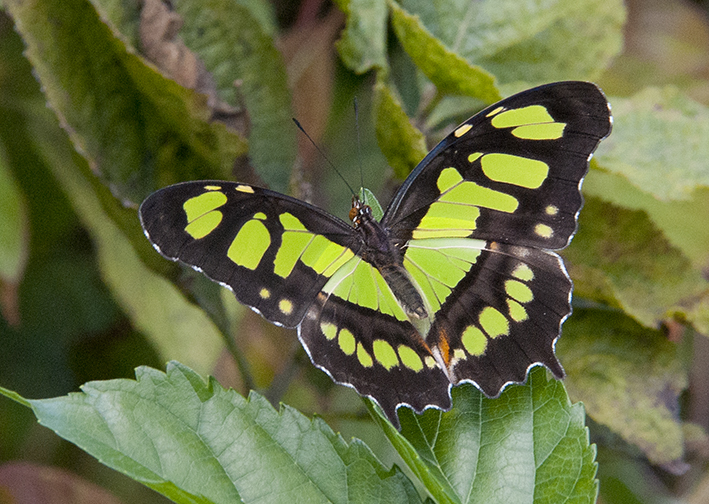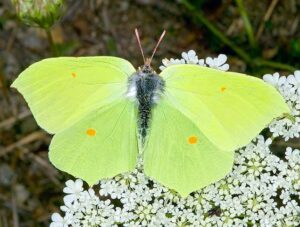
Malachite
The Malachite (Siproeta stelenes) is a species of tropical butterflies and a member of the brush-footed butterfly group. They are one of the most familiar butterfly species in South America and are known for their unusual coloration and large size. In fact, with a wingspan of up to 100mm, they are one of the largest butterfly species of the world.
Did you know?
The Malachite gets its name from the mineral malachite that bears the same shade of green.
Butterfly: Wingspan: 2¾ – 3¼ inches (7.1 – 8.4 cm) UPPER SURFACE (dorsal) Black/brown with translucent green patches. Inner hindwing with small, reddish-brown mark. UNDER SURFACE (ventral) Mixture of reddish-brown, creamy white, and pearly green. A white stripe edged with reddish-brown bisects hindwing. Large.
Egg: Translucent green. Flattened orb; pale, vertical ribs. Laid singly on host leaves and flower bracts.
Caterpillar: Velvety black; rows of long, branched spines. Those on back are orange, red, or pink; tipped with black. Head with prominent branched black or red horns. Anal claspers dull purple.
Chrysalis: Lime green; small dark dots sporadically placed; four rows of short, golden spikes protrude at top of abdomen. Head with two dark-tipped horns. Plump. Hangs from a dark cremaster.
Siproeta stelenes (malachite) is a Neotropical brush-footed butterfly (family Nymphalidae). The malachite has large wings that are black and brilliant green or yellow-green on the upperside and light brown and olive green on the underside. It is named for the mineral malachite, which is similar in color to the bright green on the butterfly’s wings. Typically, the wingspread is between 8.5 and 10 cm (3.3 and 3.9 in). The malachite is found throughout Central and northern South America, where it is one of the most common butterfly species. Its distribution extends as far north as southern Texas and the tip of Florida, to Cuba as subspecies S. s. insularis (Holland, 1916), and S. s. biplagiata, and south to Brazil.
Adults feed on flower nectar, rotting fruit, dead animals, and bat dung. Females lay eggs on the new leaves of plants in the family Acanthaceae, especially Ruellia. The larvae are horned, spiny, black caterpillars with red markings, The pupal stage is green, with sharp, gold spines that can puncture predators.
Malachites often are confused with the heliconiine Philaethria dido. They have similar coloration, but their wing shapes are different.


The only documented record of Malachite in Alabama occurred on October 29, 2002, when James C. (Jimmy) Stevenson observed an adult resting on a large holly bush in Mobile. He recalls that October had been particularly stormy that year. Stevenson collected the butterfly, and the specimen is now housed at the Auburn Museum of Natural History.
Cuban-based Malachites colonized Florida in the 1960’s. Although their populations were knocked back after Hurricane Andrew, they have continued to populate south Florida, moving into central Florida by late summer. They are not considered wanderers, and Alabama has one of the only Malachite records for the Southeast, outside of Florida.


Subfamily: Nymphalinae
Identification: Upperside is dark brown to black with translucent whitish green or yellow-green patches. Underside is orange-brown with greenish patches. Dry season (winter) form is larger and the hindwing underside has smudged black marks inside the orange marginal band; wet season (summer) form is smaller and has silver marks instead of black smudges.
Wing Span: 3 1/4 – 4 inches (8.3 – 10.1 cm).
Life History: Males perch on shrubs in forest or orchard openings and sometimes patrol for females with a slow, floating flight. Adults roost together under the leaves of low shrubs. Eggs are laid singly on host plant leaves, which caterpillars eat and rest beneath.
Flight: Two to three broods during the summer; one brood of the winter form hibernates.
Caterpillar Hosts: Cafetin (Blechum brownei) and ruellia (Ruellia coccinea) in the family Acanthaceae.
Adult Food: Rotting fruit. Occasionally feeds on bird droppings and nectar from flowers of lianas, trees, and sometimes herbaceous plants. Malachites may feed all day long and may fly to flowers 38 feet high in the canopy.
Habitat: Mango, citrus, and avocado orchards in Florida; subtropical evergreen or semideciduous forests in Central America.
Range: Brazil north through Central America, Mexico, and the West Indies to southern Florida and South Texas. A rare stray into Kansas. Comments: The southern Florida populations have become established since the 1960s; presumably having emigrated from Cuba.
Conservation: Monitor United States populations.
- Family name: Nymphalidae/Brush-Footed Butterflies
- General description: Dark brown with green spots and patches; hindwing with short tail. Ventral wing surfaces as above but paler orange-brown.
- Field Marks: Dark brown with green spots and patches
- Sexes: Appear similar
- Wingspan: 70-80 mm
- Life Cycle: Egg: Green, laid singly on host leaves Mature larva: Black with numerous orange-based black branched spines Chrysalis: Green
- Number of Generations: Three or more generations
- Flight Season: All year
- Abundance: Uncommon
- Habitat: Forest margins, clearings, overgrown plantations
- Larval Host Plants: Green Shrimp Plant (Blechum brownei)
- Similar Species: No similar species
- Additional Information: Colonies are locally common; adults are relatively long-lived; considered by many to be Florida’s most beautiful butterflies

The malachite has large wings that are black and brilliant green or yellow-green on the upper-side and light brown and olive green on the underside. It is named for the mineral malachite, which is similar in color to the bright green on the butterfly’s wings. Adults feed on flower nectar, rotting fruit, dead animals, and bat dung. Females lay eggs on the new leaves of plants in the Acanthaceae family, especially ruellia. The larvae are horned, spiny, black caterpillars with red markings. Malachites often are confused with Philaethria dido. They have similar coloration, but their wing shapes are different.
Named after the mineral Malachite, this butterfly loves to eat! Often mistaken for the Scarce Bamboo Page due to their similar coloring, Malachite Butterflies have a variety of flowers and foods that they’ll go for. They’re known to make a meal of the flowers of trees, herbaceous plants, and sometimes even the dung (poop) of birds. They’ve even been known to go after flowers up to 38 feet in the air on the canopy, which is typically where males will perch and sometimes, look for females to mate with.


